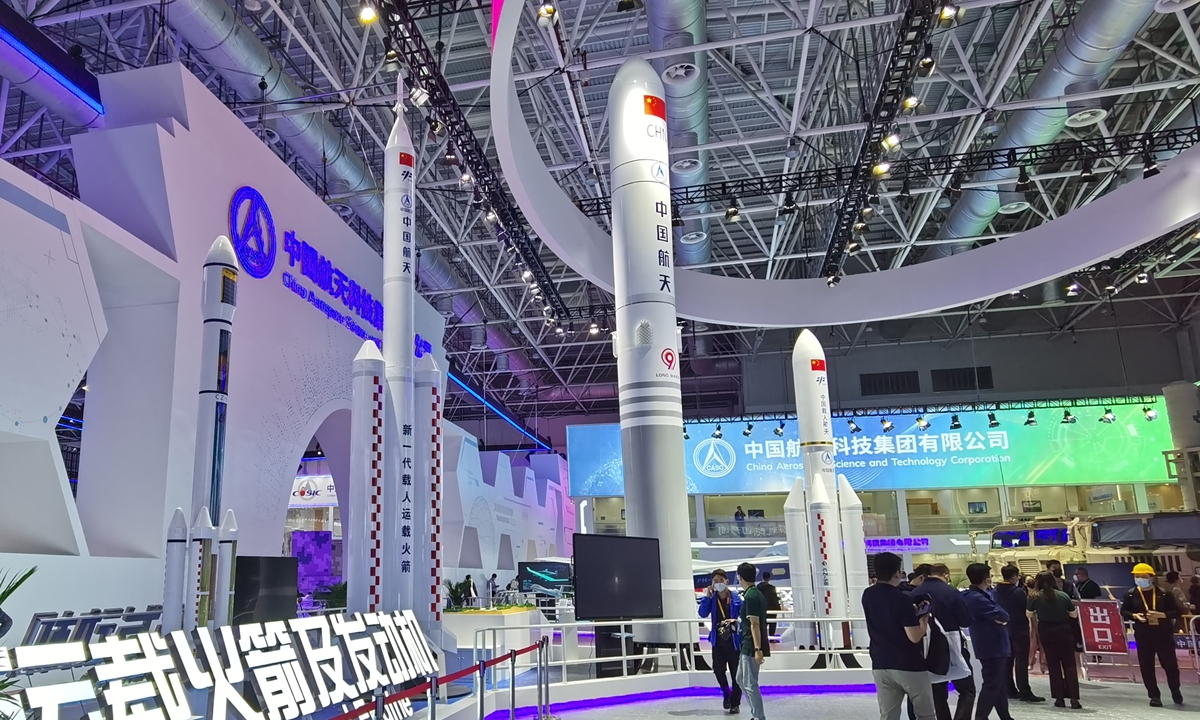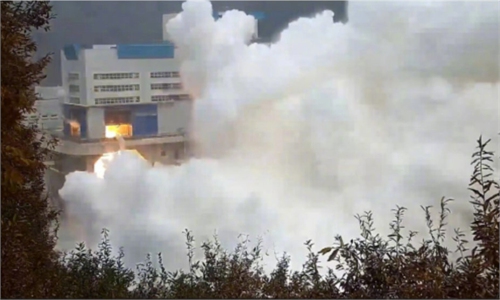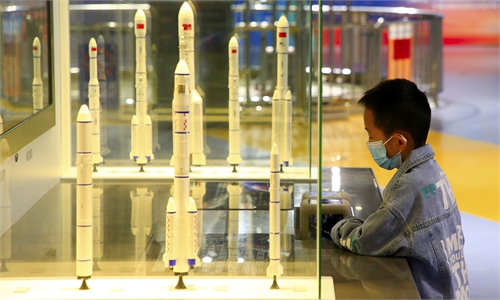China displays next-generation manned rocket for moon landing at Airshow China; craft projected to be maiden flight-ready by 2027

CASC exhibition area at the 14th China International Aviation and Aerospace Exhibition in Zhuhai, South China's Guangdong Province Photo: Courtesy of CASC
While the US NASA is targeting November 14 for the yet another launch attempt for the repeatedly scrubbed Artemis I - the inaugural flight of its ambitious moon and eventually Mars crewed landing, China is showcasing the model of the country's own new-generation manned launch vehicle at the 14th China International Aviation and Aerospace Exhibition in Zhuhai, South China's Guangdong Province with good news on the launcher's latest development.
The model of the in-development launcher is standing tall at the China Aerospace Science and Technology Corp (CASC) exhibition area.
The CASC revealed in a statement it provided to the Global Times on Tuesday that the new-generation manned rocket is designed and developed in accordance with Chinese manned space authorities overall plan and it is commissioned to launch China's new-generation manned spacecraft or the moon surface lander, with emphasis on high reliability and high safety.
Currently, developers are concluding the research stage with newly achieved technological breakthroughs and the rocket is moving into a prototype development stage, according to the CASC.
According to the CASC, it will be a three and a half stages launcher that stretches 90 meters in height, 5 meters in diameter and weighs some 2,187 tons at launch. Possessing a launch thrust of 2,678 kilonewtons and two 5-meter-diameter boosters, it is capable of sending payload of 27 tons directly to the Lunar Transfer Orbit (LTO), or payload of 70 tons to the near-Earth orbit, per the CASC.
"It will be the key strategic support in the country's advancing into a space power. It is expected to reach maiden flight conditions by 2027," the CASC said.
"The new-generation manned rocket will be smarter than any rocket currently in service, and will see attempts in reusability technology," Liu Bing, director designer of the General Design Department at the CASC's China Academy of Launch Vehicle Technology (CALT), told the Global Times during an exclusive interview in Zhuhai.
To meet the requirements of manned moon landing, the launcher has made key technology breakthroughs in the fields of highly reliable health management and autonomous flight control, and it will be able to adjust flight plans all the way from the liftoff to the separation stage of the payload spacecraft from the rocket, Liu revealed.
That means it is capable of updating target orbit parameters and reset flight control once malfunction results are detected after liftoff, Liu explained.
Reusability technology will be explored on the in-development launcher. The manned moon landing launcher could also be modified at the core stages to go without boosters in order to support near-Earth manned spaceflight missions and be usable at the same time, Liu noted.
Also, the new-generation manned launch vehicle will adopt universal products in the range of structure including the configuration system, and engines of its core stage and boosters, so that it can significantly boost manufacturing efficiency and reduce the cost, Liu said.
Alongside the model new-generation manned rocket, the CASC also displays the model of super heavy-lift carrier rocket, whose coating shows a clear Long March-9 mark. It will be a 10-meter-diamter, three-stage mega rocket, which will significantly boost China's space entry capability and enhance the country's scale and scope of space resource use.
According to the CASC, it is capable of sending payload of 150 tons to the near-Earth orbit, 50 tons to the LTO and 35 tons to the Mars Transfer Rocket. The first flight of the Long March-9 vehicle could be expected around 2030.
Liu, during a recent interview with the state broadcaster China Central Television (CCTV), said that the new heavy-lift launcher, different from previous models on display at the Airshow China, is equipped with grid fin which will play a key part in realizing the rocket body's recycle and reuse.
Although the configuration of the heavy-lift launch vehicle is still under feasibility study and it could have new changes in the future, Liu said "the goals of constantly breaking through technology difficulties and increasing its launching power are unwaveringly still."
Ahead of the opening of the Airshow China, the CASC announced on Saturday that it has made two breakthroughs in China's aerospace power systems.
The CASC Sixth Academy has successfully completed the first test of the country's self-developed largest-thrust vacuum liquid rocket engine which carries a maximum thrust of 500 tons after nearly 10 years of research and development.
The thrust of the 500-ton liquid engine is more than four times that of the 120-ton liquid oxygen-kerosene engine that is currently in service in China.
CASC also successfully completed another test for the first time for the country's largest-thrust vacuum liquid oxygen-methane engine with a maximum thrust of 80 tons, which is reusable, low-cost and high-performing.




